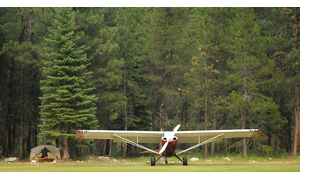
From the ITD Vault: March 1997
Aeronautic's Adopt-An-Airport program prime example
of public/private partnership at work
Partnerships joining private citizens or groups with Idaho's public agencies are becoming increasingly popular, and are proving to be a highly efficient and effective means of accomplishing needed improvements. More importantly, as with the Idaho Transportation Department's Division of Aeronautics Adopt-An-Airport program, these unions produce something of benefit to both parties, and often to all Idahoans.
Keeping these out-of-the-way airports open and maintaining emergency-use and recreational access is an important part of Idaho's frontier lifestyle.![]()
"Keeping them open for all to use is very necessary," said Mike Nickerson, a member of one of the original-and current-participating groups in the program, the Coeur d'Alene chapter of the Idaho Aviation Association. Unfortunately, the Division of Aeronautics has neither the staff nor money to undertake this task alone. But through the partnership, it can be done.
The program matches volunteers with one of the state's 30 remote airports in need of routine repair. After an airport has been adopted, volunteers are given a list of the work that needs to be done. Activities usually include general cleanup, repair of facilities, removal of brush and weeds, irrigating, mowing and other needed improvements. Such work has included gopher control, fence repair, painting, and repair work on picnic tables and repair of campsites. Volunteers are often asked to install new fencing around the perimeter of the landing and takeoff area in order to keep domestic animals from taking up residence in the middle of the airstrip. Cleanup usually takes one to four weekends during the summer.
In 1996, Nickerson's group adopted the airport at Magee. The Magee Airport has a 2,450-foot-long runway, picnic and camping area, toilets and two tie-down areas to park airplanes. It's about 80 miles into the mountains east of Coeur d'Alene. In addition to mowing the runway about six times, filling holes and cleaning up debris, the volunteers were called on in an unexpected way.
Early in the year, high water from the floods in North Idaho washed out a section of riverbank about 20 feet long and 10 feet deep, allowing water, rocks and debris to wash across the north end of the dirt and grass runway. The volunteers took a backhoe into the airport, plugged the breach to stop water from washing across the runway and removed driftwood and debris from the airport.
The mutually beneficial nature of the partnership is not lost on Nickerson. "We love the backcountry and recreational flying, and if there were no volunteers for this program, we would be in jeopardy of losing these facilities," he explained.
As reference, he points to the situation in Washington State, where quite a few small airports have been shut down recently. "ln Idaho, we have a wide variety of outdoor attractions," Young said. "But without a program like Adopt-An Airport, many of those opportunities would be lost because our agency alone doesn't have the time or money to devote to keep some of these remote airstrips open," he explained. "The Division of Aeronautics has always provided whatever is needed to complete volunteer work, including heavy equipment at times," added Young.
As for the future of Adopt-An-Airport, the program will thrive, primarily because of concerned people like Nickerson, who know the value of Idaho's backcountry airports.
"We get compliments on them all the time," said Nickerson.
"Often out-of-state pilots and airplane groups will fly in just to help out when they hear that volunteers are going to be working at a specific airport on a specific day," he added.
And the cooperation is reciprocated by Nickerson and others, who lend a hand to other groups when the need arises. ln fact, Nickerson, who was president of his pilot's group when they first began in the Idaho program and is still a front-line player, is also a member of the pilot's associations in Washington and Montana. Utah is starting an Adopt-An-Airport program similar to Idaho's, and when it does, Nickerson also will be involved there.
The Adopt-An-Airport program has been very successful during its six years of existence. Last year, volunteers also adopted the backcountry wilderness airports at New Meadows, Warm Springs, Bruce Meadows, Smith's Prairie, Big Creek, Pine, Henry's Lake, Murphy Hot Springs and Stanley.
"Simply stated," said Young, "to lose the opportunity to experience a vital part of Idaho's amazing wilderness would be a tragedy, especially when there is an easy way to keep that door open."
For more information, or to sign up for the program, please contact Young at 1-208-334-8893.
Editor’s 2017 Note: The Division of Aeronautics reports at least 26 volunteers offered their time in 2016. Many pilots have been volunteering for more than 20 years at the backcountry airports at Smith’s Prairie, Warm Springs, Magic Reservoir, Copper Basin, Twin Bridges, Pine, and Thomas Creek. The tasks vary a bit from airport to airport, but immense time and cost is saved by Aeronautics not having to do the work. Volunteers not only serve at our state airports, but also Forest Service and Bureau of Land Management (BLM) airports as well.
Published 03-17-17